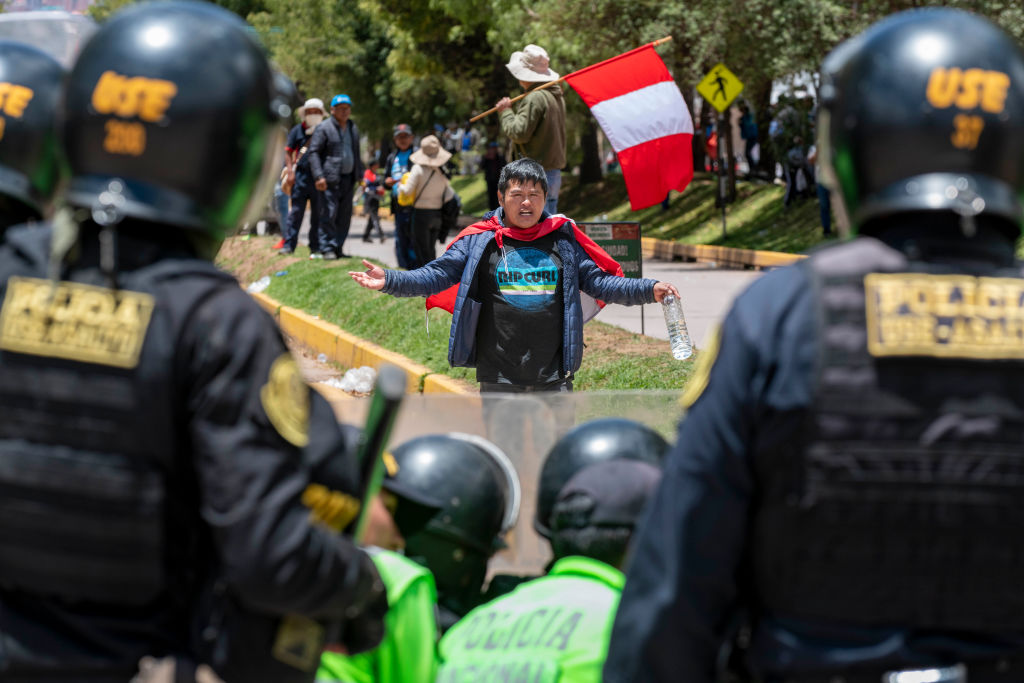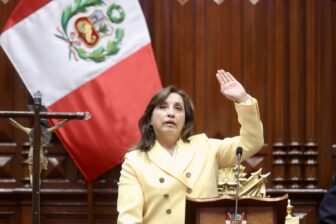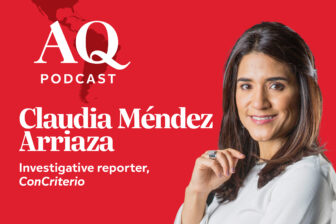AREQUIPA, Peru—Turning on my radio, I tune to the station La Decana de Juliaca, and immediately hear broken and angry voices urging the resignation of President Dina Boluarte. Regional governors in Puno, Cusco and Apurímac have made the same demand of Boluarte, who has not made a public statement since January 9, after 17 civilians were killed by police and a policeman was burned to death in his patrol car.
On the morning of January 12, merchants in the Andrés Avelino Cáceres market in Arequipa closed their shops in solidarity with the deaths in Juliaca and in protest against Boluarte’s government. Access roads to Arequipa are blocked. Demonstrations in Peru’s south have not ceased. On January 11, Cusco suffered its first death in these demonstrations: Remo Candia, president of a peasant organization.
Over the past few weeks, Peru has gone from instability to brutality. Protests ongoing since the impeachment of Pedro Castillo, following his abortive attempt to dissolve Congress on December 7, 2022, have escalated. Behind the unrest and repression is the disconnect between political machinations in Lima and public sentiment in the country’s more indigenous, rural, and poor regions—and a frayed social fabric that could provide opportunity for would-be authoritarians.
Dina Boluarte, who became the first female president in the history of Peru after Castillo’s impeachment, quickly declared her intention to remain in office until the expiration of her predecessor’s term in 2026. Congress, Peru’s most unpopular state power, supported her, hoping to stay in office longer and postpone an expensive campaign.
But Boluarte and Congress failed to realize that the initial decision not to move up elections would be interpreted as a betrayal by many in rural areas, who despite accusations of corruption and incompetence, felt a strong connection to Castillo (who denies any wrongdoing).
Boluarte was elected as Castillo’s vice president on the left-wing Perú Libre party ticket, with support from rural areas, including Peru’s south. But she was expelled from Perú Libre in January 2022 and distanced herself from other left-wing groups in Congress. Now, as president, facing a notoriously hostile Congress with no coalition of her own, she seems to be seeking support from the political right.
Subscribe to the Americas Quarterly Podcast on Apple, Spotify, Google and Soundcloud
Pedro Castillo had managed to stay in office in part because his status as a teacher from the poor region of Cajamarca carried a powerful symbolic value in many Andean areas. Instead of attempting to reassure these popular sectors of her own attention to their interests, Boluarte’s remarks on entering office seemed directed at shoring up support in Congress.
To many in Peru’s south, the message was clear: Not only did Boluarte seem to want to stay in office, but she had also betrayed them. Protestors vented their fury in Ayacucho, Arequipa, Apurímac, Cusco and Puno. By the time Boluarte backtracked (on December 11, after two deaths in Apurímac), proposing to bring elections forward to April 2024, the damage had already been done. Violence and repression escalated. In Ayacucho, where the wounds left by murders carried out by terrorists and the military during the 1980s are still fresh in collective memory, seven deaths at the hands of military forces on December 15 was especially bitter news.
Flaring up again after a Christmas lull, fresh demonstrations in January gave way to brutal repression when, on January 9, protesters tried to take over Juliaca’s airport. Unrest in Peru’s south has deep roots. The region’s political demands—expressed in its voters’ support for figures like Ollanta Humala, Verónika Mendoza and Pedro Castillo—have been languishing on the back burner for many years.
But broader social issues like the management of mining resources or the distribution of wealth aren’t part of protestors’ immediate demands. Most protesters demand early general elections, the resignation of Dina Boluarte and the closure of Congress. Some are also demanding a constituent assembly to write a new constitution.
Meanwhile, in Lima, Prime Minister Alberto Otárola is seeking to win support by taking a harsh line on the protests. In a speech before Congress, he pledged to defend democracy “at any cost” and has avoided taking political responsibility for the deaths. While in past governments, the deaths of protestors—in 2002 and 2009, for example—provoked Cabinet resignations, so far there have been none. Congress seems unwilling to back down and move general elections further forward in an attempt to lessen the social upheaval.
Boluarte’s government and Prime Minister Otárola announced a program of support and compensation for victims and the appointment of a commission to identify them. But massive processions bearing the coffins of those killed in Puno have shown that the demonstrators have forsworn dialogue so long as this government remains in power. Meanwhile, Congress is committed to its attempts at political reform on highly unpopular issues—such as parliamentary re-election—which it is intent on pursuing exclusively through expert recommendations, which disconnects them from citizens’ opinion. As a result, protests look set to increase.
The making of Peru’s crisis
As Peru’s instability worsens, its politics remain fractured. The country has operated for some time without functional political parties, but the situation has become even worse: Peru now lacks not just parties but also credible politicians who can govern effectively, channel popular energies and build bridges.
One reason the country’s crisis has not yet bottomed out is that the economy is surviving, despite everything. The Central Bank remains independent, and prior technocratic governments put the country on autopilot towards economic growth. But there were downsides to this. Peru was left better prepared for economic crises than for political ones. The liberal reforms of the 1990s were left unfinished, especially in health, education, and decentralization. The pandemic revealed how weak is the Peruvian state’s ability to help its citizens in times of need, and millions of Peruvians earn a living through informal work or on the margins of illegal mining and smuggling.
Peru is spiraling towards ungovernability. In the 1990s, chaos allowed the rise of an authoritarian leader, Alberto Fujimori, in hopes of restoring order. Since 2001, democracy has survived more through the incompetence of the politicians who have attacked it (like Manuel Merino or Pedro Castillo) rather than through the strength of its foundations. But what if the next authoritarian is not so clumsy? Boluarte’s government is demonstrating the desire in Lima and among Peru’s establishment for iron-fist policies. What remains to be seen is whether a competent, authoritarian figure will emerge to take advantage of the situation.
—
Banda is a professor of political science at the Universidad Católica de Santa María in Arequipa and a columnist at El País.







